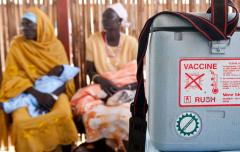Bigger, Hotter Cities - Challenges and Opportunities
This blog is the second of a four-part blog series focused on growing cooling needs for populations worldwide and opportunities for providing sustainable cooling solutions. The blogs are running in advance of a major report, “Chilling Prospects: Providing sustainable cooling for all,” coming out on July 16. The report is authored by Sustainable Energy for All.
Cities around the world are growing as people mass migrate to denser urban centers. Global average temperatures are also rising, with urban temperatures climbing at even faster rates. Heat waves are becoming more extreme, lasting longer and happening more frequently. Extreme heat, already the deadliest natural disaster in an average year, is becoming increasingly deadly.
You have likely heard about this dangerous mix of trends, one of the most recent examples being Karachi, Pakistan, where dozens died last month from extreme heat. They frame and call attention to a looming global threat – extreme urban heat and the life-or-death risks it creates for poor, vulnerable populations. The soon-to-be-released Cooling for All report, from Sustainable Energy for All and the Kigali Cooling Efficiency Program, will illuminate the massive scale of the challenge.
Alarm bells are ringing, and rightly so. More than a billion people, many of them living in cities, lack access to basic cooling services they need to survive and thrive. One study shows that cities can expect average high temperatures to increase by 3 to 5 degrees Celsius and low temperatures to increase by 3 to 7C by 2050.
But there is another aspect to the heat challenge that should not be lost. Addressing urban heat is much more than “avoiding a negative.”It is an investment that could drive a multi-billion dollar economic engine in cities around the world – from Phoenix and New York City in the U.S., to New Delhi, India to Karachi, Pakistan. A growing body of research finds that the broad benefits of cooling down cities – such as improved energy efficiency, worker productivity, air quality, health, and equity – are potentially worth hundreds of millions or even billions of dollars to a single city. This is an economic engine that will particularly benefit low-income and currently vulnerable urban populations and rural communities.
A 2017 study published in the journal Nature Climate Change shows the two sides of the coin quite well. Inaction on urban heat will cost the average city nearly 6% of its GDP by 2100. Think of that as a tax with no services rendered in return. On the flip side, the study found that the investing in sensible heat mitigating measures, like reflective, lighter-colored roofs and pavement, would generate a 1200% return! As the Cooling for All report will highlight, capturing this “cooling access dividend” should be the focus of global efforts to address rising temperatures.
How much cooler can we make our cities? A comprehensive review on this topic finds that when an overall increase in a city’s reflectivity is considered, the expected mean decrease of the average ambient temperature is close to 0.3°C, per 0.1 increase in reflectivity (an increase equivalent to going from black to a medium gray color), while the corresponding average decrease of the peak ambient temperature is close to 0.9°C. A 2014 study shows that green roofs with relatively abundant moisture cooled air temperatures reduce by up to 3.5°C over the Baltimore, Maryland–Washington, D.C. metropolitan area, and a cool roof with a reflectivity of 0.7 reduced air temperatures by 3°C.
More broadly, higher reflectivity results in regional cooling. Almeria, Spain has a unique tradition of whitewashing its greenhouses and thus reflects more sunlight than neighboring regions. Remarkably, based on a 20-year study comparing weather station data, researchers found that Almeria cooled down by 0.4°C compared to a 0.3°C rise in temperatures in surrounding regions lacking whitewashed greenhouses.
There are many more examples of communities, large and small, that are prospering by cooling down. !Kheis is a community of 15,000 people in one the hottest parts of South Africa. Homes in !Kheis were routinely too hot to enter during the day and families often have to sleep outside. The community also lacked job opportunities for many of its residents. Several years ago, a visionary municipal manager, Theresa Scheepers, decided to tackle the issue. Working with local and international organizations, she piloted a series of highly reflective cool coatings on several homes. Residents immediately noticed the temperature difference and improvements in comfort, which led to a bigger rollout (about 500 homes have been coated as of now).
But rather than using a “one-off” philanthropic model, the community focused on using the pilots to create a series of career and business opportunities for local residents. Local labor formulates the coatings, mixes them, preps the surfaces, and applies the coatings to the structures. These businesses are now expanding to other communities, creating sustainable jobs in an area that desperately needs them. This visionary program that started as a small pilot is now spreading to bigger cities in South Africa.
!Kheis teaches us that prosperity from cool communities is available to all, not just big cities and those with access to big finance and high-technology. Urban heat mitigation is an urgent opportunity that, if seized, would dramatically improve the world in the coming decades.



